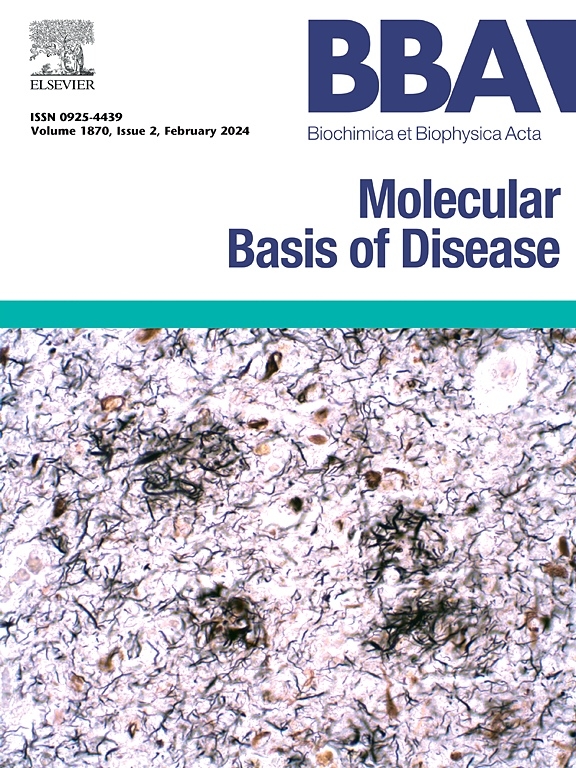人工智能辅助的多组学分析揭示了预测AD的新标志物。
IF 4.2
2区 生物学
Q2 BIOCHEMISTRY & MOLECULAR BIOLOGY
Biochimica et biophysica acta. Molecular basis of disease
Pub Date : 2025-05-27
DOI:10.1016/j.bbadis.2025.167925
引用次数: 0
摘要
阿尔茨海默病(AD)是最常见的神经退行性疾病,其特征是进行性认知能力下降。早期和准确的诊断对于改善患者预后至关重要,但目前的诊断方法仍然具有侵入性、昂贵和可及性有限。本研究利用人工智能(AI)和机器学习方法进行多组学分析,整合蛋白质组学和转录组学数据,以确定早期AD预测的潜在生物标志物。利用多个ad相关数据库和人工智能支持的文献回顾工具,我们提取并分析了来自各种组织的基因表达谱,包括脑、脑脊液(CSF)和血浆。构建蛋白相互作用(PPI)网络,利用中心性分析确定关键枢纽基因。我们的研究结果揭示了13个常见的中枢基因,包括APP、YWHAE、YWHAH、SOD1、UQCRFS1、ATP5F1B、AP2M1、MMAB、INA、RPL6、HADHB、CD63和CTNNB1,它们与早期和晚期AD都有显著关系。此外,途径富集分析确定了与AD进展相关的关键途径,如氧化磷酸化、代谢途径和突触传递。此外,9个常见的mirna和8个关键分子轴被确定,突出了早期和晚期AD之间的潜在机制联系。这些发现为阿尔茨海默病的病理生理学提供了新的见解,并为开发用于早期检测的非侵入性生物标志物提供了基础。这些生物标志物的未来实验验证对于将这些发现转化为临床应用至关重要。本文章由计算机程序翻译,如有差异,请以英文原文为准。
AI-assisted multi-OMICS analysis reveals new markers for the prediction of AD
Alzheimer's Disease (AD) is the most prevalent neurodegenerative disorder, characterized by progressive cognitive decline. Early and accurate diagnosis is crucial for improving patient outcomes, yet current diagnostic methods remain invasive, costly, and limited in accessibility. This study leverages artificial intelligence (AI) and machine learning approaches to perform a multi-omics analysis, integrating proteomics and transcriptomics data to identify potential biomarkers for early AD prediction. Using multiple AD-related databases and AI-powered literature review tools, we extracted and analyzed gene expression profiles from various tissues, including brain, cerebrospinal fluid (CSF), and plasma. A protein-protein interaction (PPI) network was reconstructed to determine key hub genes using centrality analysis. Our findings revealed 13 common hub genes, including APP, YWHAE, YWHAH, SOD1, UQCRFS1, ATP5F1B, AP2M1, MMAB, INA, RPL6, HADHB, CD63, and CTNNB1, that are significantly implicated in both early and advanced AD. Furthermore, pathway enrichment analysis identified critical pathways such as oxidative phosphorylation, metabolic pathways, and synaptic transmission, which are associated with AD progression. Additionally, nine common miRNAs and eight key molecular axes were determined, highlighting potential mechanistic links between early and advanced AD. These findings offer novel insights into AD pathophysiology and provide a foundation for developing non-invasive biomarkers for early detection. Future experimental validation of these biomarkers is essential to translate these findings into clinical applications.
求助全文
通过发布文献求助,成功后即可免费获取论文全文。
去求助
来源期刊
CiteScore
12.30
自引率
0.00%
发文量
218
审稿时长
32 days
期刊介绍:
BBA Molecular Basis of Disease addresses the biochemistry and molecular genetics of disease processes and models of human disease. This journal covers aspects of aging, cancer, metabolic-, neurological-, and immunological-based disease. Manuscripts focused on using animal models to elucidate biochemical and mechanistic insight in each of these conditions, are particularly encouraged. Manuscripts should emphasize the underlying mechanisms of disease pathways and provide novel contributions to the understanding and/or treatment of these disorders. Highly descriptive and method development submissions may be declined without full review. The submission of uninvited reviews to BBA - Molecular Basis of Disease is strongly discouraged, and any such uninvited review should be accompanied by a coverletter outlining the compelling reasons why the review should be considered.

 求助内容:
求助内容: 应助结果提醒方式:
应助结果提醒方式:


